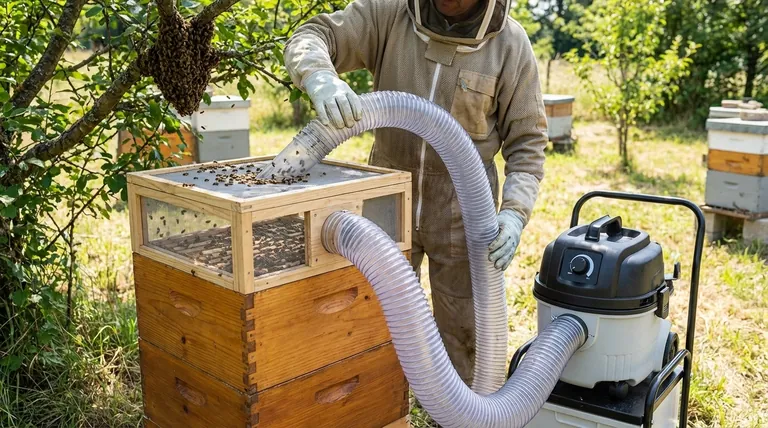At its core, a bee vacuum is a specialized tool designed for the gentle collection of honeybees, not for cleaning. Its primary components are a low-power suction source, a collection hose, and a specially designed reception bin that prioritizes the safety and health of the bees.
The fundamental principle of a bee vacuum is not raw power, but controlled, gentle airflow. The entire system is engineered to safely transport bees from a swarm or structure into a secure, well-ventilated container with minimal stress or harm.

Deconstructing the Bee Vacuum System
A successful bee vacuum balances three critical elements to ensure the colony can be relocated safely. Each part plays a specific role in protecting the bees during the collection process.
The Suction Source
The motor is the heart of the system, but it must be a gentle one. A standard shop or home vacuum cleaner is far too powerful and will injure or kill the bees.
The ideal source is a low-power vacuum or one with a reliable variable speed control. This allows you to dial in the minimum amount of suction needed to lift the bees into the hose.
The Collection Hose
The hose acts as the transport tube for the bees. It must be wide enough to allow easy passage and have a smooth interior to prevent injuring their delicate wings and bodies.
A typical setup uses a standard vacuum hose attachment, which is then connected to the reception bin, not directly to the vacuum motor's intake.
The Reception Bin
This is the most critical component for bee survival. The reception bin, or bee box, is where the bees accumulate after being suctioned. It must be designed for their safety.
It needs to be large enough to dissipate the force of the incoming air, preventing bees from being slammed against the far wall. Crucially, it must have excellent ventilation to prevent the colony from overheating.
For beekeepers, using a housing container that is the same size as a standard hive body (like a Langstroth deep box) makes transferring the collected colony into its permanent home significantly easier.
Common Pitfalls and Critical Adjustments
Simply connecting a vacuum to a box is a recipe for disaster. The nuances of airflow and bee biology are what make a bee vacuum effective and humane.
The Danger of Excessive Suction
The single biggest mistake is using too much power. High-velocity air can tear wings, crush bodies, and agitate the colony to a dangerous degree.
Always start with the lowest possible suction setting and increase it only as needed. The goal is to gently lift the bees, not violently suck them in.
The Need for Airflow Control
An effective design incorporates an adjustable air vent or gate on the reception bin. This allows you to bleed off excess suction from the motor, giving you fine-tuned control over the airflow at the hose nozzle.
This feature is more important than the specific power of the motor itself, as it provides the ability to regulate the system for different conditions.
Avoiding Dust Bags at All Costs
A standard vacuum dust bag must never be used. The tumbling action and lack of ventilation inside a bag is lethal to bees. The reception bin must be an open, ventilated space.
Making the Right Choice for Your Goal
Your specific objective will determine the ideal components for your bee vacuum setup.
- If your primary focus is a single swarm capture: A simple DIY build using a small, low-power vacuum and a modified 5-gallon bucket with ample ventilation can be effective.
- If your primary focus is frequent removals or structural "cut-outs": A purpose-built system with variable speed control and a reception box compatible with your hive equipment is a worthwhile investment.
- If your primary focus is maximizing bee safety: Prioritize a design with an oversized reception bin and multiple adjustable vents to create the gentlest possible collection environment.
Ultimately, a well-designed bee vacuum is a tool of conservation, built to protect these vital pollinators during relocation.
Summary Table:
| Component | Key Function | Critical Feature |
|---|---|---|
| Suction Source | Provides gentle airflow to lift bees | Low-power motor or variable speed control |
| Collection Hose | Transports bees from swarm to bin | Smooth interior, wide diameter |
| Reception Bin | Safely houses collected bees | Excellent ventilation, adequate size |
Ready to build or upgrade your bee removal toolkit?
HONESTBEE supplies commercial apiaries and beekeeping equipment distributors with the high-quality, wholesale components needed for effective and humane bee vacuums. From durable hoses to ventilated bee boxes compatible with standard hive equipment, we provide the reliable supplies for successful relocations.
Contact HONESTBEE today to discuss your equipment needs and ensure the safety of your vital pollinators.
Visual Guide

Related Products
- HONESTBEE Professional Long Handled Hive Tool with Precision Cutting Blade
- Professional Dual-End Stainless Steel Hive Tool for Beekeeping
- Commercial Grade Vertical Electric Bee Sweeper for Bee Removal
- HONESTBEE Professional Multi-Functional Hive Tool with Ergonomic Wood Handle
- Multi-Function Plier-Style Frame Grip Hive Tool
People Also Ask
- Why do hive tools have a hole? Unlock the Secret to Efficient Beekeeping
- What are the features of a regular hive tool? The Essential Multi-Tool for Every Beekeeper
- How should beekeepers handle bees when using a hive tool? Master Calm, Deliberate Techniques
- What are the basic tools for beekeeping? Essential Starter Kit for Safe & Successful Hive Management
- How can a hive tool be used to remove propolis and burr comb? Master Hive Maintenance for a Healthy Colony



















